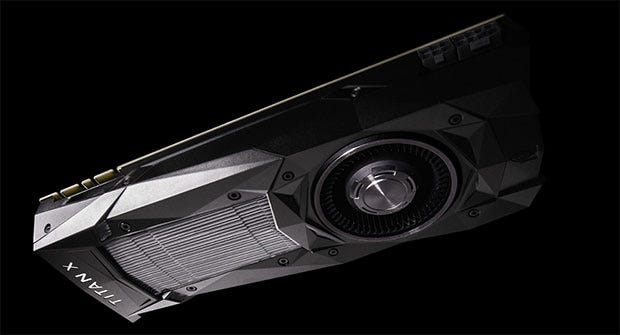Why Nvidia is overcharging us all off, just a bit
When frustration turns into offence
As I was saying, Intel’s CPU strategy has gone into meltdown. As a consequence, the cynicism of its approach in the face of weak competition - right up until AMD pulled its new Ryzen out of the proverbial - has been laid bare. But it’s not just Chipzilla that’s worthy of your scorn. For some time now, Nvidia has essentially been ripping us all off just a little bit. Here’s why.
The basis of my argument goes something like this. Nvidia’s GeForce GTX 1080 isn’t based on a high-end GPU. It’s based on a mid-sized GPU with a 256-bit memory bus that’s cheap to manufacture.
I could go through all the technicalities comparing GPU die sizes over the years, dissecting the implications of bus width, drilling down into the history of the G**04 series of chips dating back to the Kepler graphics architecture. But for those who know the details and don’t agree, it won’t make any difference. For everyone else it’s just dull.
Anyway, up to a point, it’s all academic. The GeForce GTX 1080 Ti and the Titan boards are not only based on Nvidia’s biggest GPU but also pitched higher up in the market. What, exactly, is the problem?
It comes down to this. The way these things are flogged, the essential ruse is that Ti and Titan are part of a new even higher-end segment that was added in on top of what used to be the high end. The regular 1080 is high end. The stuff above is something newer, something even higher end. But that’s bollocks.
Admittedly, it’s all been enabled by the brilliance of Nvidia’s engineers. The transition began with the Kepler generation of cards, AKA the GeForce 400 series. But it was Maxwell, which underpins graphics cards like the GTX 980, where the new paradigm really got locked in. Nvidia had come up with a graphics architecture so effective that its mid-sized GPU could trade blows with or even beat AMD’s biggest GPU.
Suddenly, Nvidia could pitch a middling GPU into a premium market segment and style its true high end GPU as something even more exotic.
There is, of course, an extent to which this is all academic. What matters is the performance of these things and the gaming experience you get, not any of the crap I’ve been talking about, right?
I don’t think so, no. Because the net result is that Nvidia’s high end GPUs and in turn the best gaming experience gets pushed up into even more exclusive territory and we all end up paying, to put it in the historical terms of an Nvidia GPU family that predates all this nonsense, GeForce GTX 280 money for a GeForce GTX 260 gaming experience. And that is what makes me grumpy.
 The GeForce GTX 1080 Ti: High end times a thousand
The GeForce GTX 1080 Ti: High end times a thousand
It’s also where the parallel with Intel’s current woes comes in. As the Linus Tech Tips guy puts it, Intel got into this mess because it lost sight of the simple strategy of making the best products it can and offering them for the best prices it can. For far too long, Intel has put far too much emphasis on trying to triangulate its market opportunities rather than just aiming to produce great products. It’s in just that kind of territory that Nvidia has been operating of late, too. The net result is that we as customers get more and more screwed over.
As this point, you might argue a BBC-esque pursuit of even handedness, not to mention a certain sense of rotational narrative symmetry, implores we stick the boot into AMD. There is indeed plenty to moan about when it comes to AMD. Indeed, it’s AMD’s failure to compete at certain times in the respective GPU and CPU markets that’s been the underlying enabler in all of this.
What’s more, AMD currently seems to be conspiring to swap its dysfunctionality from CPUs to graphics. The new Ryzen CPU is a huge improvement and has Intel in a major flounce.
Unfortunately, there seems at least a danger that its Radeon graphics tech is going south just as fast. The new AMD Vega family of GPUs grows ever later and what indications we do have of its performance, which come courtesy of some early-access Founders Editions cards, suggests that the big Vega GPU is if anything not quite on pace with Nvidia’s middling Pascal GPU in the form of the GeForce GTX 1080.
Problem is, Pascal is shortly going to be replaced by Nvidia’s new Volta technology. So, that situation is only going to get worse. To put it another way, AMD is a full generation behind Nvidia and it can’t really compete fully with Nvidia’s last gen tech, let alone the new stuff coming through.
Let me repeat that. I hope I am wrong. But it looks like even if AMD Vega was fully available right now it wouldn’t be all that stellar. By the time it does eventually limp onto the market, Nvidia will have something even faster on offer.
The point about all that, however, is that it’s about failure to deliver. Call it incompetence if you want, what it’s not is anything remotely like the cynicism and implied belligerence towards customers that Intel and Nvidia share. Hell, maybe AMD would be beating up its customers too, given half chance. But it never tends to do well enough for long enough for the abusive or practices or cynical product positioning to kick in. So who can say.
Either way, as it stands, it’s the difference between being frustrated and offended. AMD may be frustrating. But Intel and Nvidia are a little bit offensive.








